This article needs additional citations for verification .(September 2018) |
This article needs additional citations for verification .(September 2018) |

Italy is the second largest producer in Europe and in the world of olive oil production with a national average of more than 464,000 tons, of which two thirds extra virgin and less than 41 PDO and PGI recognized by the EU. In Italy, the olive tree is spread over approximately one million hectares in the primary culture and on a surface slightly less cultured, subsidiary with crops or with other tree species (vines, citrus, almond, etc.). Regarding the altitude areas, the olive has spread to 2% in the mountains, 53% hills and 44% plains. To the characteristics of the plant, which requires a mild climate, the cultivation of olive trees in Italy is widespread in the central regions (19%) and South ( 77.9%), while in the north the production is more limited ( 2%), but increasing, particularly focusing in some areas more temperate microclimate, such as Liguria and the hills around Lake Garda. The plants are producing about 170 million farms that deal olives are more than a million, so the average areas under cultivation are of the order of about one hectare, reflecting the extreme land fragmentation . [1]
Strawberry-tree, thorn, ivy; rare as Barena honey, fruit of the Venetian lagoon and the small flowers that appear when the tide retreats, or more widespread such as sunflower. Italy boasts an unbeatable record: 51 varieties, all surveyed by the Ministry of Agriculture, compared with only 10 to 15 other countries. Produced throughout the boot, including the islands, but especially in the northern and central regions, particularly Emilia Romagna, Lombardy, Veneto and Piedmont. Less than in the south, despite the enviable climate. Blame the smaller presence of beekeepers.
Mastic in Italy it is diffused in Liguria, on the peninsula and in the islands. On the western Adriatic coast does not go beyond Ancona. In the eastern dates back much further north reaching the entire coast of Istria.

Italy is the world's largest wine producer. [2]

Merlot is a dark blue–colored wine grape variety that is used as both a blending grape and for varietal wines. The name Merlot is thought to be a diminutive of merle, the French name for the blackbird, probably a reference to the color of the grape. Its softness and "fleshiness," combined with its earlier ripening, make Merlot a popular grape for blending with the sterner, later-ripening Cabernet Sauvignon, which tends to be higher in tannin.

Cabernet Sauvignon is one of the world's most widely recognized red wine grape varieties. It is grown in nearly every major wine producing country among a diverse spectrum of climates from Australia and British Columbia, Canada to Lebanon's Beqaa Valley. Cabernet Sauvignon became internationally recognized through its prominence in Bordeaux wines, where it is often blended with Merlot and Cabernet Franc. From France and Spain, the grape spread across Europe and to the New World where it found new homes in places like California's Napa Valley, New Zealand's Hawke's Bay, South Africa's Stellenbosch region, Australia's Margaret River, McLaren Vale and Coonawarra regions, and Chile's Maipo Valley and Colchagua. For most of the 20th century, it was the world's most widely planted premium red wine grape until it was surpassed by Merlot in the 1990s. However, by 2015, Cabernet Sauvignon had once again become the most widely planted wine grape, with a total of 341,000 hectares (3,410 km2) under vine worldwide.

Hérault is a department of the region of Occitania, Southern France. Named after the Hérault River, its prefecture is Montpellier. It had a population of 1,175,623 in 2019.
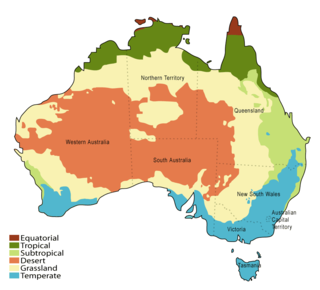
Although Australia is mostly arid, the nation is a major agricultural producer and exporter, with over 325,300 people employed in agriculture, forestry and fishing as of February 2015. Agriculture and its closely related sectors earn $155 billion a year for a 12% share of GDP. Farmers and grazers own 135,997 farms, covering 61% of Australia's landmass. Across the country, there is a mix of irrigation and dry-land farming. The success of Australia in becoming a major agricultural power despite the odds is facilitated by its policies of long-term visions and promotion of agricultural reforms that greatly increased the country's agricultural industry.

Italian wine is produced in every region of Italy. Italy is the world's largest wine producer, as well as the country with the widest variety of indigenous grapevine in the world, with an area of 702,000 hectares under vineyard cultivation, and contributing a 2013–2017 annual average of 48.3 million hl of wine. In 2018 Italy accounted for 19 per cent of global production, ahead of France and Spain. Italian wine is both exported around the world and popular domestically among Italians, who consume an average of 42 litres per capita, ranking fifth in world wine consumption.

Argentina is the fifth largest producer of wine in the world. Argentine wine, as with some aspects of Argentine cuisine, has its roots in Spain. During the Spanish colonization of the Americas, vine cuttings were brought to Santiago del Estero in 1557, and the cultivation of the grape and wine production stretched first to neighboring regions, and then to other parts of the country.

Agriculture in Greece is deeply rooted in history, and based on its Mediterranean climate. This practice encompasses a wide array of crops, including olives, grapes, citrus fruits, cereals, and vegetables, with a notable emphasis on olive oil production, establishing Greece as a global leader in this industry. The country's vineyards produce tons of grapes and also yield renowned wines. Greece also produces a wide variety of livestock products. Fisheries are playing an important role while forestry plays a secondary role.
South African wine has a history dating back to 1659 with the first bottle being produced in Cape Town by its founder and governor Jan van Riebeeck. Access to international markets led to new investment in the South African wine market. Production is concentrated around Cape Town and almost exclusively located within the Western Cape province, with major vineyard and production centres at Constantia, Paarl, Stellenbosch and Worcester.

Spanish wine includes red, white, and sparkling wines produced throughout the country. Located on the Iberian Peninsula, Spain has over 1.2 million hectares planted in wine grapes, making it the most widely planted wine-producing nation, but the second largest producer of wine in the world, behind Italy and ahead of France and the United States. This is due, in part, to the very low yields and wide spacing of the old vines planted on the dry soils found in some of the Spanish wine regions. The country is ninth in worldwide consumption with Spaniards drinking, on average, 21.6 litres per person a year. The country has an abundance of native grape varieties, with over 400 varieties planted throughout Spain, though 88 percent of the country's wine production is from only 20 grapes — including the reds Tempranillo, Bobal, Garnacha, and Monastrell; the whites Albariño, Airén, Verdejo, Palomino, and Macabeo; and the three Cava grapes Parellada, Xarel·lo, and Macabeo.
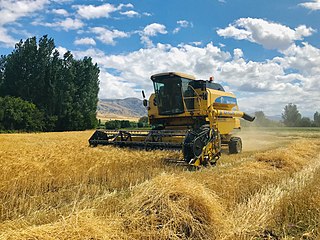
Agriculture is still an important sector of Turkey's economy, and the country is one of the world's top ten agricultural producers. Wheat, sugar beet, milk, poultry, cotton, vegetables and fruit are major products; and Turkey is the world's largest grower of hazelnuts, apricots, and oregano.
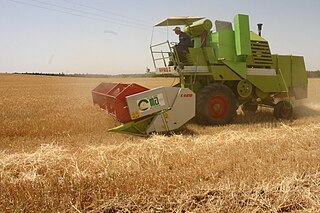
Agriculture in Algeria composes 25% of Algeria's economy and 12% of its GDP in 2010. Prior to Algeria’ colonization in 1830, nonindustrial agriculture provided sustenance for its population of approximately 2-3 million. Domestic agriculture production included wheat, barley, citrus fruits, dates, nuts, and olives. After 1830, colonizers introduced 2200 individual farms operated by private sectors. Colonial farmers continued to produce a variety of fruits, nuts, wheat, vegetables. Algeria became a large producer of wine during the late 19th century due to a crop epidemic that spread across France. Algeria's agriculture evolved after independence was achieved in 1962. The industry experienced multiple policy changes modernize and decry on food imports. Today, Algeria's agriculture industry continues to expand modern irrigation and size of cultivable land.

Agriculture in Morocco employs about 40% of the nation's workforce. Thus, it is the largest employer in the country. In the rainy sections of the northwest, barley, wheat, and other cereals can be raised without irrigation. On the Atlantic coast, where there are extensive plains, olives, citrus fruits, and wine grapes are grown, largely with water supplied by artesian wells. Livestock are raised and forests yield cork, cabinet wood, and building materials. Part of the maritime population fishes for its livelihood. Agadir, Essaouira, El Jadida, and Larache are among the important fishing harbors. Both the agriculture and fishing industries are expected to be severely impacted by climate change.

Agriculture in Albania is still a significant sector of the economy of Albania, which contributes to 22.5% of the country's GDP. The country spans 28,748 square kilometres of which 24% is agricultural land, 36% forest land, 15% pasture and meadow and 25% urban areas including lakes, waterways, unused rocky and mountain land. It can be separated into three main zones such as the lowland zone alongside the coastline of the country, the hill zone in the lowland and the mountain zone.

Agriculture in Spain is important to the national economy. The primary sector activities accounting for agriculture, husbandry, fishing and silviculture represented a 2.7% of the Spanish GDP in 2017, with an additional 2.5% represented by the agrofood industry.
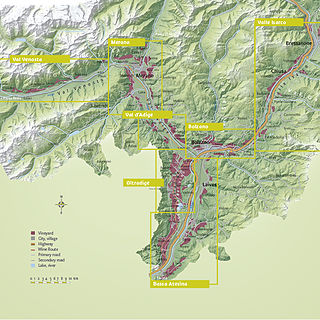
South Tyrol is an autonomous province located in northeast Italy producing wine. This Austro-Italian wine region is noted for the distinct Austrian influences on the wine industry, due to the region's long history under the rule of Austria-Hungary and Holy Roman Empires.
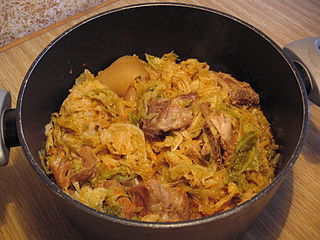
Lombard cuisine is the style of cooking in the Northern Italian region of Lombardy. The historical events of its provinces and of the diversity of its territories resulted in a varied culinary tradition. First courses in Lombard cuisine range from risottos to soups and stuffed pasta, and a large choice of second course meat or fish dishes, due to the many lakes and rivers of Lombardy.
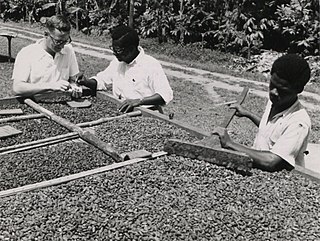
Ghana is the second-largest exporter of cocoa beans in the world, after Ivory Coast. Ghana's cocoa cultivation, however, is noted within the developing world to be one of the most modeled commodities and valuables.

The cuisine of Corsica is the traditional cuisine of the island of Corsica. It is mainly based on the products of the island, and due to historical and geographical reasons, has much in common with Italian cuisine, and marginally with those of Nice and Provence.
Cocoa production is important to the economy of Nigeria. Cocoa is the leading agricultural export of the country and Nigeria is currently the world's fourth largest producer of cocoa, after Ivory Coast, Indonesia and Ghana, and the third largest exporter, after Ivory Coast and Ghana. The crop was a major foreign exchange earner for Nigeria in the 1950s and 1960s and in 1970 the country was the second largest producer in the world but following investments in the oil sector in the 1970s and 1980s, Nigeria's share of world output declined. In 2010, cocoa production accounted for only 0.3% of agricultural GDP. Average cocoa beans production in Nigeria between 2000 and 2010 was 389,272 tonnes per year rising from 170,000 tonnes produced in 1999.
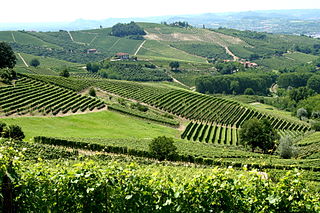
Agriculture in Italy, one of the economic sectors of the country, has developed since the 5th millennium BC. In the 20th century, Italy transformed from a predominantly agricultural country to an industrial country. As a result, the agricultural sector has seen employment drop dramatically, from 43% to 3.8% of the total, a minimal percentage in the national economic framework.